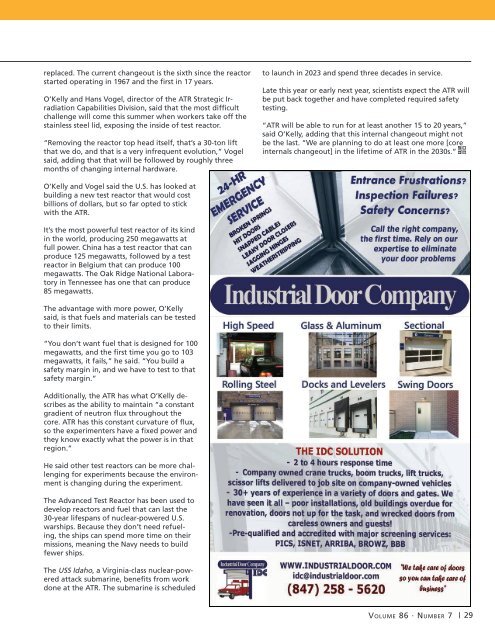CEAC-2021-07-July
Create successful ePaper yourself
Turn your PDF publications into a flip-book with our unique Google optimized e-Paper software.
eplaced. The current changeout is the sixth since the reactor<br />
started operating in 1967 and the first in 17 years.<br />
O’Kelly and Hans Vogel, director of the ATR Strategic Irradiation<br />
Capabilities Division, said that the most difficult<br />
challenge will come this summer when workers take off the<br />
stainless steel lid, exposing the inside of test reactor.<br />
“Removing the reactor top head itself, that’s a 30-ton lift<br />
that we do, and that is a very infrequent evolution,” Vogel<br />
said, adding that that will be followed by roughly three<br />
months of changing internal hardware.<br />
to launch in 2023 and spend three decades in service.<br />
Late this year or early next year, scientists expect the ATR will<br />
be put back together and have completed required safety<br />
testing.<br />
“ATR will be able to run for at least another 15 to 20 years,”<br />
said O’Kelly, adding that this internal changeout might not<br />
be the last. “We are planning to do at least one more [core<br />
internals changeout] in the lifetime of ATR in the 2030s.”<br />
O’Kelly and Vogel said the U.S. has looked at<br />
building a new test reactor that would cost<br />
billions of dollars, but so far opted to stick<br />
with the ATR.<br />
It’s the most powerful test reactor of its kind<br />
in the world, producing 250 megawatts at<br />
full power. China has a test reactor that can<br />
produce 125 megawatts, followed by a test<br />
reactor in Belgium that can produce 100<br />
megawatts. The Oak Ridge National Laboratory<br />
in Tennessee has one that can produce<br />
85 megawatts.<br />
The advantage with more power, O’Kelly<br />
said, is that fuels and materials can be tested<br />
to their limits.<br />
“You don’t want fuel that is designed for 100<br />
megawatts, and the first time you go to 103<br />
megawatts, it fails,” he said. “You build a<br />
safety margin in, and we have to test to that<br />
safety margin.”<br />
Additionally, the ATR has what O’Kelly describes<br />
as the ability to maintain “a constant<br />
gradient of neutron flux throughout the<br />
core. ATR has this constant curvature of flux,<br />
so the experimenters have a fixed power and<br />
they know exactly what the power is in that<br />
region.”<br />
He said other test reactors can be more challenging<br />
for experiments because the environment<br />
is changing during the experiment.<br />
The Advanced Test Reactor has been used to<br />
develop reactors and fuel that can last the<br />
30-year lifespans of nuclear-powered U.S.<br />
warships. Because they don’t need refueling,<br />
the ships can spend more time on their<br />
missions, meaning the Navy needs to build<br />
fewer ships.<br />
The USS Idaho, a Virginia-class nuclear-powered<br />
attack submarine, benefits from work<br />
done at the ATR. The submarine is scheduled<br />
Volume 86 · Number 7 | 29


















